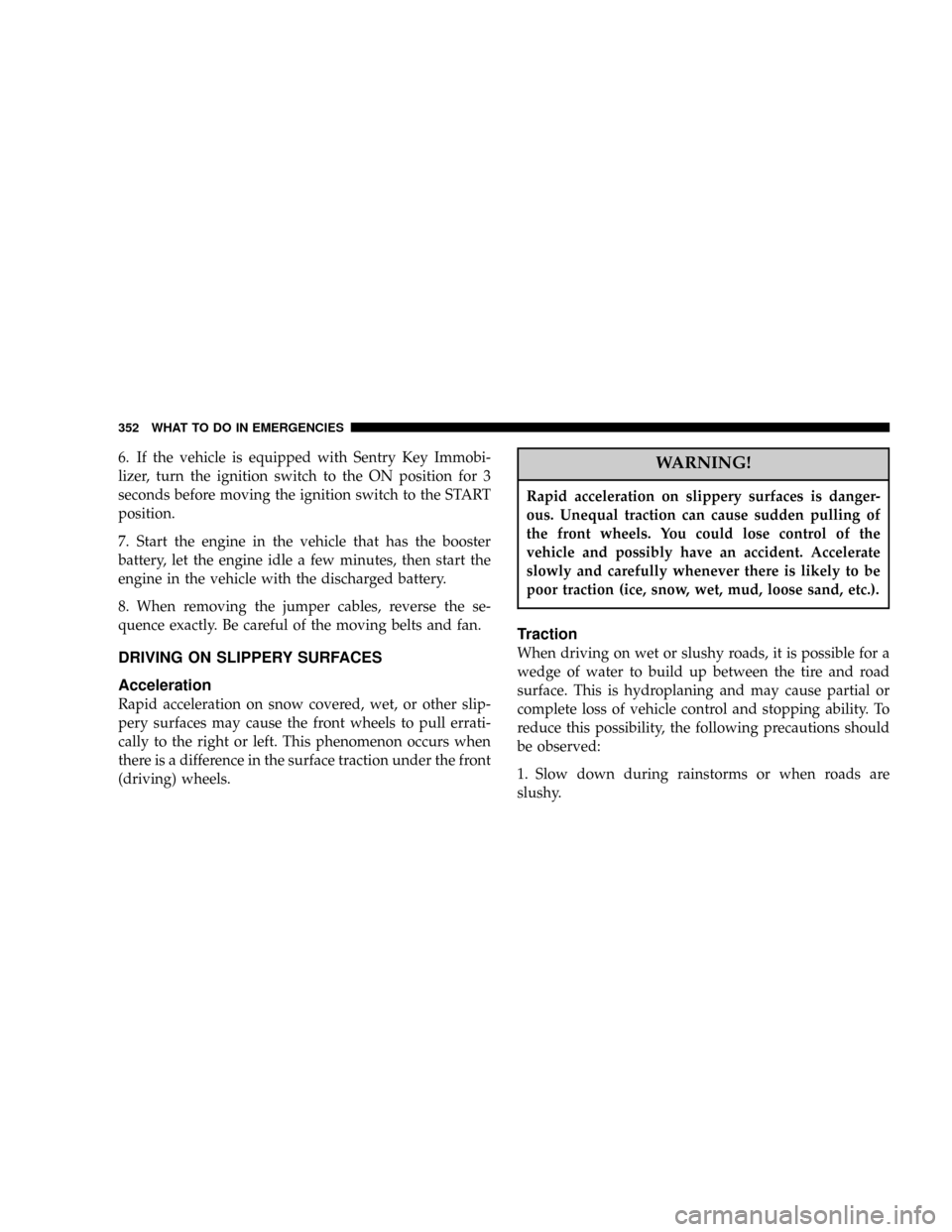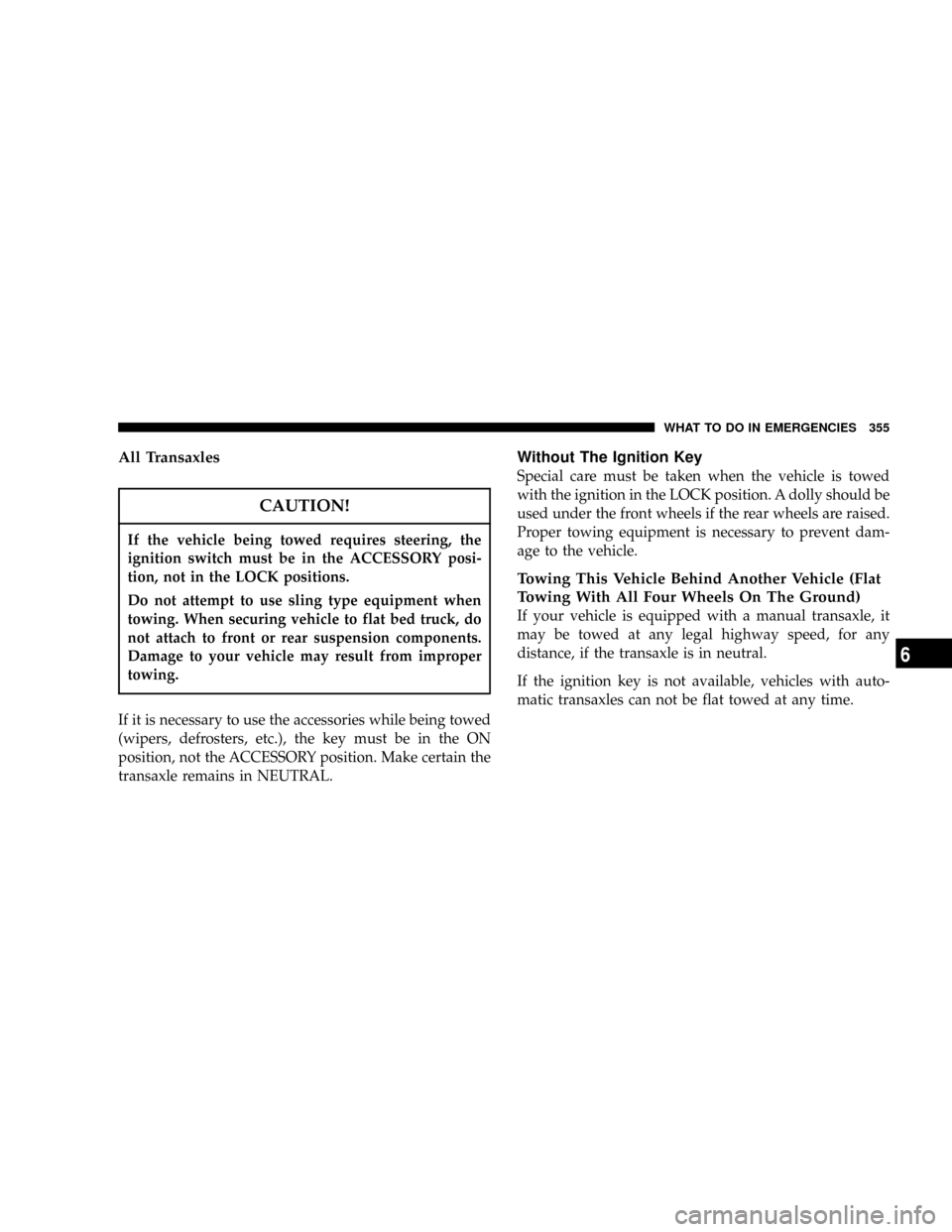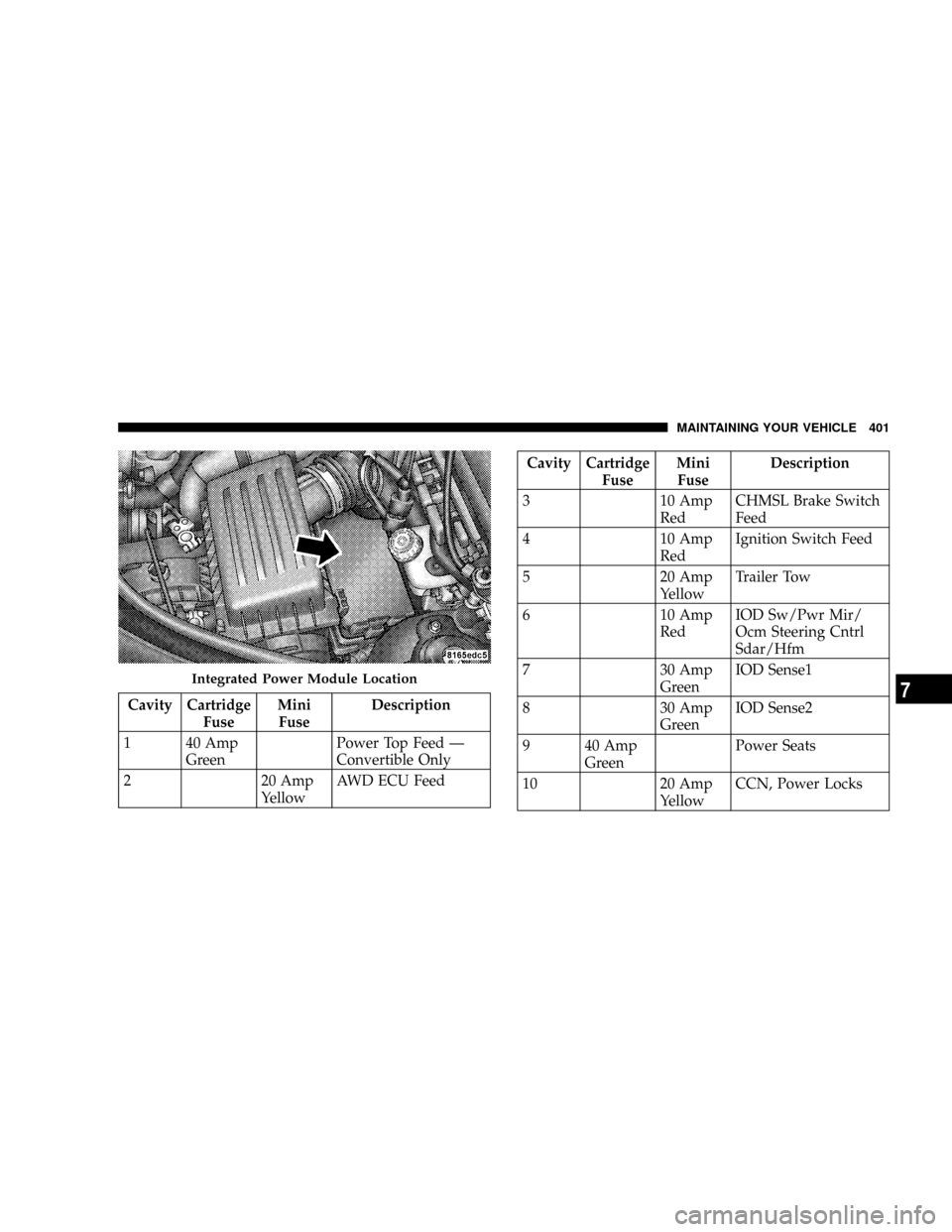ignition switch CHRYSLER PT CRUISER 2007 1.G Workshop Manual
[x] Cancel search | Manufacturer: CHRYSLER, Model Year: 2007, Model line: PT CRUISER, Model: CHRYSLER PT CRUISER 2007 1.GPages: 467, PDF Size: 7.57 MB
Page 298 of 467

The ABS light monitors the Anti-Lock Brake
System. The light will come on when the
ignition switch is turned to the ON position
and may stay on for as long as four seconds.
If the ABS light remains on or comes on while driving, it
indicates that the Anti-Lock portion of the brake system
is not functioning and that service is required. However,
the conventional brake system will continue to operate
normally if the BRAKE warning light is not on.
If the ABS light is on, the brake system should be serviced
as soon as possible to restore the benefits of Anti-Lock
brakes. If the ABS light does not come on when the
Ignition switch is turned to the ON position, have the
bulb repaired as soon as possible.
If both the Brake Warning Light and the ABS Light
remain on, the Anti-Lock brakes (ABS) and Electronic
Brake Force Distribution (EBD) systems are not function-
ing. Immediate repair to the ABS system is required.When the vehicle is driven over 7 mph (11 km/h), you
may also hear a slight clicking sound as well as some
related motor noises. These noises are the system per-
forming its self check cycle to ensure that the ABS system
is working properly. This self check occurs each time the
vehicle is started and accelerated past 7 mph (11 km/h).
ABS is activated during braking under certain road or
stopping conditions. ABS-inducing conditions can in-
clude ice, snow, gravel, bumps, railroad tracks, loose
debris, or panic stops.
You also may experience the following when the brake
system goes into Anti-lock:
²The ABS motor running (it may continue to run for a
short time after the stop),
²the clicking sound of solenoid valves,
²brake pedal pulsations,
298 STARTING AND OPERATING
Page 342 of 467

HAZARD WARNING FLASHER
The flasher switch is located on the instrument
panel, below the radio. Depress the switch and
both cluster indicators and all front and rear
directional signals will flash. Depress the
switch again to turn Hazard Warning Flashers off.
Do not use this emergency warning system when the
vehicle is in motion. Use it when your vehicle is disabled
and is creating a safety hazard for other motorists.If it is necessary to leave the vehicle to go for service, the
flasher system will continue to operate with the ignition
key removed and the vehicle locked.
NOTE:With extended use, the flasher may wear down
your battery.
IF YOUR ENGINE OVERHEATS
In any of the following situations, you can reduce the
potential for overheating by taking the appropriate ac-
tion.
²On the highways Ð Slow down.
²In city traffic Ð While stopped, put transaxle in
neutral, but do not increase engine idle speed.
If the pointer rises to theH(red) mark, the instrument
cluster will sound a chime. Pull over and stop the vehicle
with the engine at idle, when safe. Turn off the air
conditioning and wait until the pointer drops back into
Hazard Warning Switch
342 WHAT TO DO IN EMERGENCIES
Page 350 of 467

WARNING!
A loose tire thrown forward in a collision or hard
stop could injure the occupants in the vehicle. Have
the deflated (flat) tire repaired or replaced immedi-
ately.
10. Check the tire pressure as soon as possible. Correct
pressure as required.
JUMP-STARTING PROCEDURES DUE TO A LOW
BATTERY
WARNING!
Take care to avoid the radiator cooling fan whenever
the hood is raised. It can start anytime the ignition
switch is on. You can be hurt by the fan.
WARNING!
Do not attempt to push or tow your vehicle to get it
started. Vehicles equipped with an automatic trans-
axle cannot be started this way. Unburned fuel could
enter the catalytic converter and once the engine has
started, ignite and damage the converter and vehicle.
If the vehicle has a discharged battery, booster cables
may be used to obtain a start from another vehicle.
This type of start can be dangerous if done improp-
erly, so follow this procedure carefully.
1. Wear eye protection and remove any metal jewelry
such as watch bands or bracelets that might make an
inadvertent electrical contact.
350 WHAT TO DO IN EMERGENCIES
Page 352 of 467

6. If the vehicle is equipped with Sentry Key Immobi-
lizer, turn the ignition switch to the ON position for 3
seconds before moving the ignition switch to the START
position.
7. Start the engine in the vehicle that has the booster
battery, let the engine idle a few minutes, then start the
engine in the vehicle with the discharged battery.
8. When removing the jumper cables, reverse the se-
quence exactly. Be careful of the moving belts and fan.
DRIVING ON SLIPPERY SURFACES
Acceleration
Rapid acceleration on snow covered, wet, or other slip-
pery surfaces may cause the front wheels to pull errati-
cally to the right or left. This phenomenon occurs when
there is a difference in the surface traction under the front
(driving) wheels.
WARNING!
Rapid acceleration on slippery surfaces is danger-
ous. Unequal traction can cause sudden pulling of
the front wheels. You could lose control of the
vehicle and possibly have an accident. Accelerate
slowly and carefully whenever there is likely to be
poor traction (ice, snow, wet, mud, loose sand, etc.).
Traction
When driving on wet or slushy roads, it is possible for a
wedge of water to build up between the tire and road
surface. This is hydroplaning and may cause partial or
complete loss of vehicle control and stopping ability. To
reduce this possibility, the following precautions should
be observed:
1. Slow down during rainstorms or when roads are
slushy.
352 WHAT TO DO IN EMERGENCIES
Page 355 of 467

All Transaxles
CAUTION!
If the vehicle being towed requires steering, the
ignition switch must be in the ACCESSORY posi-
tion, not in the LOCK positions.
Do not attempt to use sling type equipment when
towing. When securing vehicle to flat bed truck, do
not attach to front or rear suspension components.
Damage to your vehicle may result from improper
towing.
If it is necessary to use the accessories while being towed
(wipers, defrosters, etc.), the key must be in the ON
position, not the ACCESSORY position. Make certain the
transaxle remains in NEUTRAL.
Without The Ignition Key
Special care must be taken when the vehicle is towed
with the ignition in the LOCK position. A dolly should be
used under the front wheels if the rear wheels are raised.
Proper towing equipment is necessary to prevent dam-
age to the vehicle.
Towing This Vehicle Behind Another Vehicle (Flat
Towing With All Four Wheels On The Ground)
If your vehicle is equipped with a manual transaxle, it
may be towed at any legal highway speed, for any
distance, if the transaxle is in neutral.
If the ignition key is not available, vehicles with auto-
matic transaxles can not be flat towed at any time.
WHAT TO DO IN EMERGENCIES 355
6
Page 365 of 467

a9clicking9sound is heard. This is an indication that the
gas cap is properly tightened. Press the odometer reset
button to turn the message off. If the problem persists,
the message will appear the next time the vehicle is
started. This might indicate a damaged cap. If the prob-
lem is detected twice in a row, the system will turn on the
Malfunction Indicator Light (MIL). Resolving the prob-
lem will turn the MIL light off.
EMISSIONS INSPECTION AND MAINTENANCE
PROGRAMS
In some localities, it may be a legal requirement to pass
an inspection of your vehicle's emissions control system.
Failure to pass could prevent vehicle registration.
For states, which have an I/M (Inspection and
Maintenance) requirement, this check verifies the
following: the MIL (Malfunction Indicator Light)is functioning and is not on when the engine is running,
and that the OBD (On Board Diagnostic) system is ready
for testing.
Normally, the OBD system will be ready. The OBD
system maynotbe ready if your vehicle was recently
serviced, if you recently had a dead battery, or a battery
replacement. If the OBD system should be determined
not ready for the I/M test, your vehicle may fail the test.
Your vehicle has a simple ignition key actuated test,
which you can use prior to going to the test station. To
check if your vehicle's OBD system is ready, you must do
the following:
1. Insert your ignition key into the ignition switch.
2. Turn the ignition to the ON position, but do not crank
or start the engine.
3. If you crank or start the engine, you will have to start
this test over.
MAINTAINING YOUR VEHICLE 365
7
Page 381 of 467

when the underside or rear of the vehicle is damaged;
have a competent technician inspect the complete ex-
haust system and adjacent body areas for broken, dam-
aged, deteriorated, or mispositioned parts. Open seams
or loose connections could permit exhaust fumes to seep
into the passenger compartment. In addition, inspect the
exhaust system each time the vehicle is raised for an oil
change or lubrication. Replace as required.
WARNING!
Exhaust gases can injure or kill. They contain carbon
monoxide (CO) which is colorless and odorless.
Breathing it can make you unconscious and can
eventually poison you. To avoid breathing CO, refer
to Exhaust Gas in the Safety Tips section of this
manual.
Cooling System
WARNING!
²When working near the radiator cooling fan, dis-
connect the fan motor lead or turn the ignition
switch to the OFF position. The fan is temperature
controlled and can start at any time the ignition
switch is in the ON position.
²You or others can be badly burned by hot coolant
or steam from your radiator. If you see or hear
steam coming from under the hood, don't open
the hood until the radiator has had time to cool.
Never try to open a cooling system pressure cap
when the radiator is hot.
MAINTAINING YOUR VEHICLE 381
7
Page 401 of 467

Cavity Cartridge
FuseMini
FuseDescription
1 40 Amp
GreenPower Top Feed Ð
Convertible Only
2 20 Amp
YellowAWD ECU Feed
Cavity Cartridge
FuseMini
FuseDescription
3 10 Amp
RedCHMSL Brake Switch
Feed
4 10 Amp
RedIgnition Switch Feed
5 20 Amp
YellowTrailer Tow
6 10 Amp
RedIOD Sw/Pwr Mir/
Ocm Steering Cntrl
Sdar/Hfm
7 30 Amp
GreenIOD Sense1
8 30 Amp
GreenIOD Sense2
9 40 Amp
GreenPower Seats
10 20 Amp
YellowCCN, Power Locks
Integrated Power Module Location
MAINTAINING YOUR VEHICLE 401
7
Page 456 of 467

Gasoline (Fuel).......................321,410
Gasoline, Reformulated................... 323
Gauges
Coolant Temperature.................... 224
Fuel................................ 224
Odometer........................... 225
Tachometer.......................... 225
Gearshift.............................. 285
General Information....................17,159
General Maintenance..................... 367
Glass Cleaning.......................... 397
Gross Axle Weight Rating.................. 329
Gross Vehicle Weight Rating................ 329
Hands-Free Phone (UConnectŸ)............. 134
Hazard Warning Flasher................... 342
Head Restraints......................... 165
Headlights
Bulb Replacement...................... 406Cleaning............................ 397
High Beam........................185,230
High Beam/Low Beam Select Switch........ 185
Passing............................. 185
Switch.............................. 182
Heated Seats........................... 166
Hitches
Trailer Towing........................ 331
HomeLinkt(Garage Door Opener) Transmitter . . . 193
Hood Release.......................... 178
Hoses................................ 386
Ignition............................... 13
Key ................................. 13
Wiring System (Spark Plug Wires).......... 372
Ignition Key Removal..................... 13
Immobilizer (Sentry Key).................15,36
Infant Restraint.......................72,105
Information Center, Vehicle................. 231
456 INDEX
Page 467 of 467

INTRODUCTION INTRODUCTION HOW TO USE THIS MANUAL WARNINGS AND CAUTIONS VEHICLE IDENTIFICATION NUMBER VEHICLE MODIFICATIONS/ALTERATIONS THINGS TO KNOW BEFORE STARTING YOUR VEHICLE A WORD ABOUT YOUR KEYS
Ignition Key Removal
Locking Doors With The KeyKey-In-Ignition ReminderSENTRY KEY - IF EQUIPPED Replacement KeysSentry Key ProgrammingGeneral InformationSTEERING WHEEL LOCK - IF EQUIPPED If You Wish To Manually Lock The Steering WheelTo Release The Steering Wheel
LockAutomatic Transaxle Ignition Interlock SystemDOOR LOCKS Manual Door LocksPower Door LocksChild-Protection Door Lock System (Rear Doors) - IfEquippedREMOTE KEYLESS ENTRY (SEDAN) To unlock the doors and liftgateTo lock the doors and liftgate (if
equipped with power options) Using The Panic AlarmTo Turn Off Flash Lights With LockProgramming Additional TransmittersGeneral InformationBattery ReplacementREMOTE KEYLESS ENTRY (CONVERTIBLE) To Unlock the DoorsTo lock the doorsTo Unlatch the Deck
LidPanic AlarmUsing The Panic AlarmTo Turn Off Flash Lights With LockTo Program Additional TransmittersGeneral InformationTransmitter Battery ServiceSECURITY ALARM SYSTEM - IF EQUIPPED To set the alarmTo disarm the systemSecurity System Manual Override
LIFTGATE (SEDAN) DECK LID (CONVERTIBLE) Power Deck Lid Release (Convertible)EMERGENCY SEAT BACK RELEASE (SEDAN) EMERGENCY DECK LID RELEASE LATCH (CONVERTIBLE) POWER WINDOWS Auto Down FeatureRear Window SwitchesWind
BuffetingOCCUPANT RESTRAINTS (SEDAN) Lap/Shoulder BeltsAdjustable Upper Shoulder Belt AnchorageLap/Shoulder Belt Untwisting ProcedureSeat Belt PretensionersEnhanced Seat Belt Reminder System (BeltAlert) Seat Belts And Pregnant WomenDriver and Front
Passenger Supplemental Restraint System (SRS) - AirbagChild RestraintOCCUPANT RESTRAINTS (CONVERTIBLE) Lap/Shoulder BeltsLap/Shoulder Belt Untwisting ProcedureSeat Belt PretensionersEnhanced Seat Belt Reminder System (BeltAlert) Seat Belts And
Pregnant WomenDriver and Front Passenger Supplemental Restraint System (SRS) - AirbagChild RestraintENGINE BREAK-IN RECOMMENDATIONS SAFETY TIPS Exhaust GasSafety Checks You Should Make Inside The VehiclePeriodic Safety Checks You Should Make
Outside The VehicleUNDERSTANDING THE FEATURES OF YOUR VEHICLE CONVERTIBLE TOP OPERATION To Lower The TopTo Raise The TopConvertible Top Boot Cover Installation-If EquippedConvertible Top Boot Cover Removal and StorageCONVERTIBLE TOP
MANUAL OVERRIDEMIRRORS Inside Day/Night Mirror - If EquippedOutside Mirror-Drivers SideOutside Mirror-Passengers SideElectric Remote-Control Mirrors - If EquippedIlluminated Vanity Mirrors - If EquippedSun Visor Sliding FeatureHANDS-FREE COMMUNICATION
(UConnect) - IF EQUIPPED OperationsPhone Call FeaturesUConnect System FeaturesAdvanced Phone ConnectivityThings You Should Know About Your UConnect SystemGeneral InformationSEATS Front Seat AdjustmentPower Seat Adjuster - If EquippedManual
Lumbar-If EquippedFolding Front Passenger Seat - If EquippedDrivers Seat Back Tilt-If EquippedPassenger Seat Back Tilt (Easy Entry System) (Convertible)Adjustable Head RestraintsHeated Seats - If EquippedFolding Rear Seat (Sedan)Folding Rear Seat (Convertible)
Tumbling Rear Seat (Sedan)Tumbling Rear Seat (Convertible)Rear Seat Removal (Sedan)TO OPEN AND CLOSE THE HOOD LIGHTS Map/Reading Lights (Sedan)Map/Reading Lights (Convertible)Multi-Function Control LeverHeadlights, Parking Lights, Instrument Panel
LightsDaytime Running Lights (DRL) - If EquippedLights-on ReminderFog Lights - If Equipped Turn Signals Highbeam/Lowbeam Select Switch Passing LightWINDSHIELD WIPERS AND WASHERS Windshield WashersMist Feature Windshield Wiper OperationIntermittent
Wiper SystemTILT STEERING COLUMN ELECTRONIC SPEED CONTROL - IF EQUIPPED To ActivateTo Set At A Desired SpeedTo DeactivateTo Resume SpeedTo Vary The Speed SettingManual TransaxleTo Accelerate For PassingGARAGE DOOR OPENER - IF
EQUIPPED Programming The Universal TransceiverRolling Code ProgrammingCanadian Programming/Gate ProgrammingOperationReprogramming A Single ButtonSecurityPOWER SUNROOF - IF EQUIPPED Express Open FeatureWind BuffetingSunroof Maintenance
ELECTRICAL POWER OUTLETS Electrical Outlet Use With Engine OffCONSOLE FEATURES STORAGE Center Console/Armrest Storage Bin Storage PocketsREAR SHELF PANEL- IF EQUIPPED Position 1 (Top)Position 2 (Middle)Position 3 (Floor)Position 4 (Vertical) Position 5 (table)ROOF LUGGAGE RACK - IF EQUIPPED REAR WINDOW FEATURES Electric Rear Window Defroster Rear Wiper/Washer Switch - If EquippedAdding Washer FluidUNDERSTANDING YOUR INSTRUMENT PANEL INSTRUMENT PANEL FEATURES
INSTRUMENT CLUSTER-BASE INSTRUMENT CLUSTER-PREMIUM INSTRUMENT CLUSTER-TURBO INSTRUMENT CLUSTER DESCRIPTIONS ELECTRONIC VEHICLE INFORMATIONCENTER (EVIC)-If Equipped EVIC Functions Compass/Temperature/Audio
Average Fuel EconomyDistance To Empty (DTE)Elapsed TimePersonal Settings (Customer Programmable Features)SETTING THE ANALOG CLOCK RADIO GENERAL INFORMATION Radio Broadcast SignalsTwo Types of SignalsElectrical DisturbancesAM Reception
FM ReceptionSALES CODE REF - AM/FM/CD (SINGLE DISC) RADIO WITH OPTIONAL SATELLITE RADIO AND HANDS FREE PHONE CAPABILITY Operating Instructions - Radio ModeOperation Instructions - CD ModeOperation Instructions - Auxiliary ModeOperating
Instructions - Hands Free Phone - If EquippedOperating Instructions - Satellite Radio - If EquippedSALES CODE RAQ - AM/FM/CD (6-DISC) RADIO WITH OPTIONAL SATELLITE RADIO, HANDS FREE PHONE, AND VEHICLE ENTERTAINMENT SYSTEMS (VES)
CAPABILITIES Operating Instructions - Radio ModeOperation Instructions - (CD MODE for CD Audio Play)LOAD/EJECT Button (CD Mode for CD Audio Play)Notes On Playing MP3 FilesOperation Instructions - (CD Mode for MP3 Audio Play)LOAD/EJECT Button (CD Mode
for MP3 Play)SATELLITE RADIO - IF EQUIPPED System ActivationElectronic Serial Number/Sirius Identification Number (ESN/SID)Selecting Satellite Mode in REF, and RAQ, RadiosSelecting a ChannelStoring and Selecting Pre-Set ChannelsUsing the PTY (Program Type)
Button (if equipped)PTY Button SCANPTY Button SEEKSatellite AntennaReception QualityCD/DVD DISC MAINTENANCE RADIO OPERATION AND CELLULAR PHONES CLIMATE CONTROLS Climate ControlsOperating Tips STARTING AND OPERATING STARTING
PROCEDURES Automatic TransaxleManual TransaxleNormal StartingExtremely Cold Weather (below -20 degrees F or -29 degrees C)If Engine Fails to StartAfter StartingTurbocharger Cool DownAUTOMATIC TRANSAXLE - IF EQUIPPED Brake/Transmission Interlock
SystemAutomatic Transaxle Ignition Interlock SystemFour Speed Automatic TransaxleReset ModeGear Ranges For Four Speed Automatic TransaxleAUTOSTICK - IF EQUIPPED Autostick OperationAutostick General InformationMANUAL TRANSAXLE OPERATION 2.4
Liter Turbo- If Equipped Recommended Shift SpeedsDownshiftingPARKING BRAKE BRAKE SYSTEM Anti-Lock Brake System (ABS) - If EquippedPOWER STEERINGTRACTION CONTROL SYSTEM - IF EQUIPPED TIRE SAFETY INFORMATION Tire Markings Tire
Identification Number (TIN)Tire Loading and Tire PressureTIRES - GENERAL INFORMATION Tire PressureTire Inflation PressuresRadial-Ply TiresCompact Spare Tire - If EquippedLimited Use Spare - If EquippedTire SpinningTread Wear IndicatorsLife of TireReplacement
TiresAlignment And BalanceTIRE CHAINS SNOW TIRES Tire Rotation Recommendations FUEL REQUIREMENTS 2.4L Standard Engine and 2.4L Standard Turbo Engine2.4L High Output Turbo EngineReformulated GasolineGasoline/Oxygenate BlendsMMT In Gasoline
Materials Added to FuelFuel System CautionsCarbon Monoxide WarningsADDING FUEL Fuel Filler Cap (Gas Cap)Loose Fuel Filler Cap MessageVEHICLE LOADING TRAILER TOWING Common Towing DefinitionsTrailer Hitch ClassificationTrailer Towing Weights
(Maximum Trailer Weight Ratings)Trailer and Tongue WeightTowing RequirementsTowing TipsRECREATIONAL TOWING (BEHIND MOTORHOME, ETC.) Towing This Vehicle Behind Another Vehicle (Flat towing with all four wheels on the ground)WHAT TO DO IN
EMERGENCIES HAZARD WARNING FLASHER IF YOUR ENGINE OVERHEATS JACKING AND TIRE CHANGING Jack LocationSpare Tire StowagePreparations For JackingJacking InstructionsJUMP-STARTING PROCEDURES DUE TO A LOW BATTERY DRIVING
ON SLIPPERY SURFACES AccelerationTractionFREEING A STUCK VEHICLE TOWING A DISABLED VEHICLE With Ignition KeyWithout The Ignition KeyCONVERTIBLETOP MANUAL OVERRIDE MAINTAINING YOUR VEHICLE 2.4L TURBO ENGINE COMPARTMENT
2.4L ENGINE COMPARTMENT ONBOARD DIAGNOSTIC SYSTEM - OBD II Loose Fuel Filler Cap MessageEMISSIONS INSPECTION AND MAINTENANCE PROGRAMS REPLACEMENTPARTS DEALER SERVICE MAINTENANCE PROCEDURES Engine OilDrive Belts
- Check Condition and TensionSpark PlugsIgnition Wiring SystemCatalytic ConverterEngine Timing BeltCrankcase Emission Control SystemFuel FilterAir Cleaner Element (Filter)Maintenance-Free BatteryAir Conditioner MaintenancePower Steering - Fluid CheckFront
Suspension Ball JointsBody LubricationWindshield Wiper BladesWindshield Washer ReservoirExhaust SystemCooling SystemHoses And Vacuum/VaporHarnessesFuel System ConnectionsBrake SystemAutomatic TransaxleManual TransaxleAppearance Care And
Protection From CorrosionCONVERTIBLE TOP CARE WashingGeneral CleaningCloth Top Additional Cleaning ProcedureCloth Top ProtectionWeather Strip CareINTEGRATED POWER MODULE (IPM) VEHICLE STORAGE REPLACEMENT BULBS BULB REPLACEMENT
HeadlightsFront Park/Turn Signal/Side Marker LightsFront Fog Lights - If EquippedTail/Stop, and Rear Turn Signal LightsBack Up Lights Center HighMounted Stop LightFLUIDS AND CAPACITIES FLUIDS, LUBRICANTS AND GENUINE PARTS EngineChassis
MAINTENANCE SCHEDULES EMISSION CONTROL SYSTEM MAINTENANCE MAINTENANCE SCHEDULE SCHEDULE B-ALL ENGINESSCHEDULE A-NON TURBOSCHEDULE A-TURBOIF YOU NEED CONSUMER ASSISTANCE SUGGESTIONS FOR OBTAINING
SERVICE FOR YOUR VEHICLE Prepare For The AppointmentPrepare A ListBe Reasonable With RequestsIF YOU NEED ASSISTANCE WARRANTY INFORMATION (U.S. Vehicles Only) MOPAR PARTS REPORTING SAFETY DEFECTS In CanadaPUBLICATION ORDER
FORMS DEPARTMENT OF TRANSPORTATION UNIFORM TIRE QUALITY GRADES TreadwearTraction GradesTemperature GradesINDEX